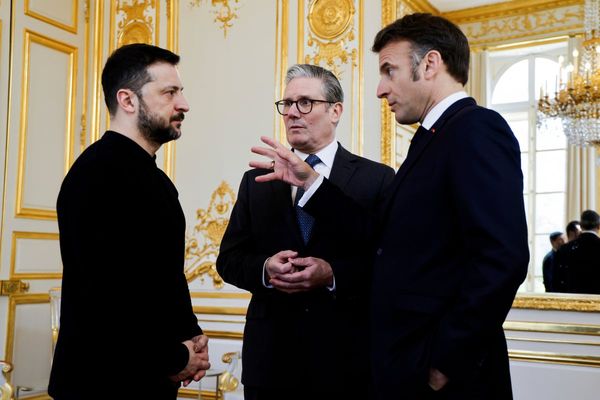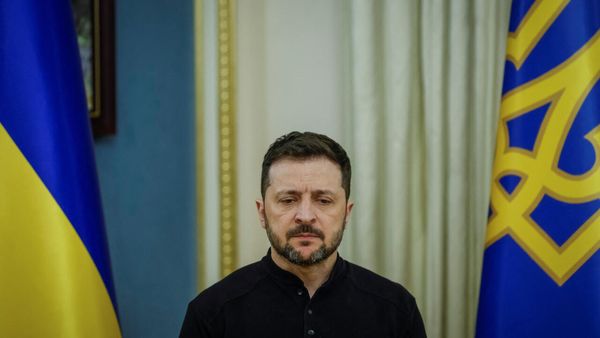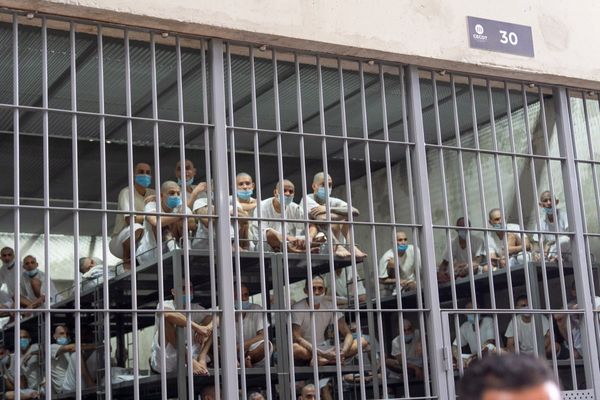
From a locker room inside Denver’s McNichols Sports Arena, Royce Gracie watched the televised carnage. The first clash inside a caged enclosure called the ‘octagon’ ended in 26 seconds with a flying tooth and the 400lb sumo wrestler it belonged to bouncing face first off the fence. Cameras caught tears welling in Teila Tuli’s eyes after the Dutchman Gerard Gordeau punted his mouth and socked him with a bare-knuckle fist. This was the cascade of violence that ushered in a martial arts revolution 25 years ago. Pausing from warming up, Royce calmly chuckled with his family in agreement: the giant Tuli should have known Gracie jiu-jitsu.
By Royce’s turn, the third bout of a single-elimination tournament that required the champion to win a trio of nearly-anything-goes hand-to-hand fights that night, Denver was awash in aggression. Viewers caught their breath as they took notice of Royce’s solemn entree into the Ultimate Fighting Championship.
Tall and slender, the Brazilian seemed suspiciously out of place ... until suddenly he wasn’t. Only aficionados would have been aware of Gracie exploits in Brazil, or of their American satellite in Torrance, California. They probably saw the VHS tapes that featured Gracies, and their students, taking on challenge matches. ‘Gracies in Action’ made the case for the family’s ground-based defense and attack strategies. Royce, a 170lb native of Rio de Janeiro, participated in several of gym showdowns, yet members of his family objected when his father Hélio and brother Rorion called his name to fight.
“A lot of the family members, including my mother, always remind me that they were against me fighting because she thought that I was the nicest one,” Royce told the Guardian. “I never had a fight in the street. I never really competed. But my brother and father decided to put me in UFC 1. She was like, ‘No, put the other brothers. Put the cousins. Put anyone but him.’”
Isabel knew there was no going back and told Royce not to listen to his dad, who lobbied for clean jiu-jitsu and limited striking from his son. She called instead for blood.
“My mother was the mean one,” Royce said. “She wanted me to rip their face apart.”
Despite the request, Royce demurred to grandmaster Hélio. He politely toyed with boxer Art Jimmerson and stridently wrenched the neck of a far more dangerous threat, shoot fighter Ken Shamrock.
In the finals, the big-kicking Gordeau resorted to digging his teeth into one of Royce’s ears. It was a panic move. Moments later, the aggressive kyokushin karate stylist frantically tapped out to the first submission any jiu-jitsu white belt learns – the mata leão, or, ‘lion killer’. For the bite, and for perhaps his mom, Royce held on to Gordeau’s strangled neck a few beats longer than needed.
Showcasing the effectiveness of the Gracie style to the wider world, Royce’s performance blew away minds and misconceptions. Regarded today mostly as a rear-naked choke, the mata leão – control a person from behind, encircle your arms around their neck and rule over their consciousness – works as well as any martial arts technique ever invented. The Gracies were taught many submissions by Japan’s legendary judo ambassador Mitsuyo Maeda. Over the years they adapted what they learned, reframed it, and passed on what they knew. This explains why, since UFC 1, the proliferation of ground fighting knowledge turned exponential. Gracie academies spread across the globe. Countless other instructors opened gyms and offered their own successful interpretations of Brazilian jiu-jitsu.

Exposed to a new truth about the martial arts, fighters pushed to determine who would be best if everyone knew what Royce did. In the last quarter-century, many learned to mix grappling with striking, too, an impulse that drew millions of fans to the modern, mainstream, multi-billon dollar enterprise known as the UFC.
Increased participation spurred on by UFC 1 heralded competition, innovation and some whispered criticisms that the Gracies couldn’t keep up. For as much as they’re known as a family of fighters, the Gracies want to be regarded as teachers. This became Hélio’s mission after taking over teaching from his brother Carlos in the early days. Several factions of Gracies, notably Carlos’s eldest son Carlson, produced incredible fighters, just no standouts from the family.
Critics point to the fact that a Gracie hasn’t captured the public’s imagination since Royce won his first 11 bouts and three of the UFC’s first four tournaments – the implication being that they took a step back against submission-schooled grapplers and mixed fighters. Beyond Royce and his cousin Renzo, who went to war with the top Luta Livre competitors from Rio’s favelas and successfully competed all over the world, there hasn’t been a champion-level Gracie since a clash of philosophies (style v style) morphed into a sporting contest.
The top name in the family at the moment is Kron, the 29-year-old son of Royce’s older brother Rickson, the square-jawed killer originally tapped to dismantle opponents at UFC 1. Kron has won gold at the most prestigious grappling events, and in the last few years turned his attention to mixed fighting. He is 4-0, but like his father has competed overseas in Japan and, despite having all the tools, has not garnered significant attention among fans as a fighter to be reckoned with.
The quest for most Gracie fighters, Royce said, has taken on the form of a rite of passage in recent years.
“There’s a lot of people who climb Mount Everest, eh? That means I’m not going to do it because it’s easy? No,” he said. “Everyone that climbs validates the whole thing. It’s a different motivation but everyone has to climb at least one time. We can’t think like this. Every fight is validation.”
Next up is Royce’s eldest son, 20-year-old Khonry, who gets the chance to take his fighting first steps on Saturday night, not for the UFC but its chief competitor in the United States, Viacom’s Bellator.
You don’t need to look hard to see Royce in Khonry, whose name is a play off the Portuguese word for honor. Same charm. Same boyish appearance. Same stoic demeanor. Same seriousness of purpose.
“He had one fight and maybe because he saw what I did before my fights but he kept himself composed the whole time,” Royce said. “He was asleep before his fight. He laid down, put a towel over his face, fell asleep and I had to wake him up. Just like I do.”
Where they differ is where all kids separate with their parents: technologically. Khonry grew up in a changed world from the one his father knew, and not because of the internet. Where jiu-jitsu once ruled all comers, it has since become a foundational piece – one of the legs – of what it takes to be a competent professional mixed martial artist. Any amateur MMA fighter in 2018 has more experience with jiu-jitsu than Royce’s opponents had at UFC 1.

Finding and creating stars has always been a crapshoot in MMA. Fighters like Royce are going to be remembered because there are so rare. His biography as a pioneer can’t be duplicated and fans on concourses around the world continue to “freak out” around Royce, said Bellator president Scott Coker. Several years ago Royce, now 51, moved on from the UFC to serve as a brand ambassador for Bellator, and this relationship led Coker to a teenage Khonry.
“You’re the son of the king of this whole movement and you’re going to have a lot of pressure on you,” Coker said. “In talking to him he has accepted the fact that he has to become a complete mixed martial artist. I ran into him when he was 17 years old and he said to me then ‘I want to sign with Bellator.’ I looked at him and questioned his age and said he had to wait a couple years. Royce said he wasn’t going to fight because he wanted him to get stronger and work on his skills.
“He’s been laying the ground work for the last three years. It’s going to be a process of competition fighting that will test him to see if he has the ability like his father or grandfather to carry on the legacy. He’s going to have every opportunity but he’s got to put in the work and do it and rise up on his own.”
Khonry was raised in the plush Southern California community of Palos Verdes playing soccer with his friends and always, always learning the family trade. He didn’t seriously consider a path other than fighting, he said, and gladly put the beautiful game aside when it was time to prove himself to the family.
“It’s very rare you find a guy like Messi or Cristiano Ronaldo out there,” Khonry told the Guardian last month in Los Angeles. “So I have a last name for this sport. I figured it’s a better path to go down.”
Conor McGregor has earned enough status through MMA to get mentions alongside the soccer kingpins, but Khonry laughed and flashed his big smile when asked if he expected to make it to their elite level.
“Ask me that after 10 fights,” Khonry noted.
Sons of sporting greats often can’t match their fathers’ accomplishments, but if they want it they’ll at least get a chance to emerge from the shadow. In the fight world it happens more than stick and ball sports. If Khonry beats fellow newcomer Devon Brock on Saturday, reaches 10-0, and Coker starts feeling like he is going to be a big deal like his dad, it will be because Royce encouraged his child to be better than he was by adding boxing, wrestling and a little judo to his jiu-jitsu foundation. This is why Royce claimed confidence in his heir’s grappling and striking skills, saying the brown belt is stronger than he ever was and can defend himself against anyone.
Royce boiled down Khonry’s chances to whether or not he, like his dad, has what Brazilians call “blood in his eyes.”
“When it’s time to go if he bites his teeth and dives into that,” the father said. “Only time will tell.”
Four months ago, Khonry appeared in the second bout of an amateur card in Tennessee. At his young age and without a competitive jiu-jitsu résumé to compare him by, the jump to pro fights seem quick. But Bellator has signed several heralded newcomers to their first pro contract in an attempt to identify and build untapped talent into draws the public will care about.
For Coker, it was worth taking a shot on Royce Gracie’s untested offspring.
“It means that the next lineage of the Gracie family is signed with Bellator,” Coker said. “I think that there’s still a fascination with the Gracie family because they were the ones who pioneered the transition. How long has it been since there was a Gracie champion? This would be a big deal in the jiu-jitsu community and the Gracie family.”
Royce labeled himself Khonry’s chief trainer, not babysitter, and will be joined in the corner by Royler and Rodrigo Gracie during the Bellator undercard bout at the Forum in Inglewood, California.
“The way I was raised was you didn’t have to be a fighter, but learn,” Royce said. “After all, it can be a blessing or a curse having the last name Gracie. You don’t know how to defend yourself? At least know what you’re doing. That’s what I tell my kids. You don’t have to teach or fight, but know because, ‘Oh, you’re Royce Gracie’s son? Can you fight?’ You see, the question is going to pop up one day in your life.”







